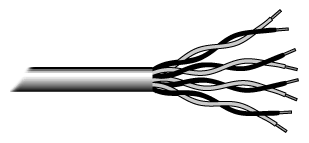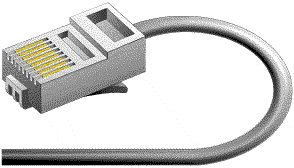The following sections discuss the types of cables used in networks and other
related topics.
Unshielded Twisted Pair (UTP) Cable
Twisted pair cabling comes in two varieties: shielded and unshielded. Unshielded
twisted pair (UTP) is the most popular and is generally the best option for
school networks (See fig. 1).

Fig.1. Unshielded twisted pairThe quality of UTP may vary from telephone-grade wire to extremely high-speed
cable. The cable has four pairs of wires inside the jacket. Each pair is twisted
with a different number of twists per inch to help eliminate interference
from adjacent pairs and other electrical devices. The tighter the twisting,
the higher the supported transmission rate and the greater the cost per foot.
The EIA/TIA (Electronic Industry Association/Telecommunication Industry Association)
has established standards of UTP and rated six categories of wire (additional categories are emerging).
Categories of Unshielded Twisted Pair
| Category | Speed | Use | | 1 | 1 Mbps | Voice Only (Telephone Wire) | | 2 | 4 Mbps | LocalTalk & Telephone (Rarely used) | | 3 | 16 Mbps | 10BaseT Ethernet | | 4 | 20 Mbps | Token Ring (Rarely used) | | 5 | 100 Mbps (2 pair) 1000 Mbps (4 pair) | 100BaseT Ethernet Gigabit Ethernet | | 5e | 1,000 Mbps | Gigabit Ethernet | | 6 | 10,000 Mbps | Gigabit Ethernet |
|
Unshielded Twisted Pair Connector
The standard connector for unshielded twisted pair cabling is an RJ-45 connector.
This is a plastic connector that looks like a large telephone-style connector
(See fig. 2). A slot allows the RJ-45 to be inserted only one way. RJ stands
for Registered Jack, implying that the connector follows a standard borrowed
from the telephone industry. This standard designates which wire goes with
each pin inside the connector.

Fig. 2. RJ-45 connectorShielded Twisted Pair (STP) Cable
Although UTP cable is the least expensive cable, it may be susceptible to radio and electrical
frequency interference (it should not be too close to electric motors, fluorescent lights, etc.). If you must place cable in environments with lots of potential interference, or if you must place cable in extremely sensitive environments that may be susceptible to the electrical current in the UTP, shielded twisted pair may be the solution. Shielded cables can also help to extend the maximum distance of the cables.
Shielded twisted pair cable is available in three different configurations:
- Each pair of wires is individually shielded with foil.
- There is a foil or braid shield inside the jacket covering all wires (as a group).
- There is a shield around each individual pair, as well as around the entire group of wires (referred to as double shield twisted pair).
Coaxial Cable
Coaxial cabling has a single copper conductor at its center. A plastic layer
provides insulation between the center conductor and a braided metal shield
(See fig. 3). The metal shield helps to block any outside interference from

Fig. 3. Coaxial cableAlthough coaxial cabling is difficult to install, it is highly resistant
to signal interference. In addition, it can support greater cable lengths
between network devices than twisted pair cable. The two types of coaxial
Thin coaxial cable is also referred to as thinnet. 10Base2 refers to the
specifications for thin coaxial cable carrying Ethernet signals. The 2 refers
to the approximate maximum segment length being 200 meters. In actual fact
the maximum segment length is 185 meters. Thin coaxial cable has been popular in
Thick coaxial cable is also referred to as thicknet. 10Base5 refers to the
specifications for thick coaxial cable carrying Ethernet signals. The 5 refers
to the maximum segment length being 500 meters. Thick coaxial cable has an
extra protective plastic cover that helps keep moisture away from the center
conductor. This makes thick coaxial a great choice when running longer lengths
in a linear bus network. One disadvantage of thick coaxial is that it does
Coaxial Cable Connectors
The most common type of connector used with coaxial cables is the Bayone-Neill-Concelman
(BNC) connector (See fig. 4). Different types of adapters are available for
BNC connectors, including a T-connector, barrel connector, and terminator.
Connectors on the cable are the weakest points in any network. To help avoid
problems with your network, always use the BNC connectors that crimp, rather

Fig. 4. BNC connectorFiber Optic Cable
Fiber optic cabling consists of a center glass core surrounded by several
layers of protective materials (See fig. 5). It transmits light rather than
electronic signals eliminating the problem of electrical interference. This
makes it ideal for certain environments that contain a large amount of electrical
interference. It has also made it the standard for connecting networks between
Fiber optic cable has the ability to transmit signals over much longer distances
than coaxial and twisted pair. It also has the capability to carry information
at vastly greater speeds. This capacity broadens communication possibilities
to include services such as video conferencing and interactive services. The
cost of fiber optic cabling is comparable to copper cabling; however, it is
The center core of fiber cables is made from glass or plastic fibers (see fig 5). A plastic coating then cushions the fiber center, and kevlar fibers help to strengthen the cables and prevent breakage. The outer insulating jacket made of teflon or PVC.
 Fig. 5. Fiber optic cable
Fig. 5. Fiber optic cableThere are two common types of fiber cables -- single mode and multimode.
Multimode cable has a larger diameter; however, both cables provide high bandwidth at high speeds. Single mode can provide more distance, but it is more expensive.
Ethernet Cable Summary
| Specification | Cable Type | | 10BaseT | Unshielded Twisted Pair | | 10Base2 | Thin Coaxial | | 10Base5 | Thick Coaxial | | 100BaseT | Unshielded Twisted Pair | | 100BaseFX | Fiber Optic | | 100BaseBX | Single mode Fiber | | 100BaseSX | Multimode Fiber | | 1000BaseT | Unshielded Twisted Pair | | 1000BaseFX | Fiber Optic | | 1000BaseBX | Single mode Fiber | | 1000BaseSX | Multimode Fiber |
|
Installing Cable - Some Guidelines
When running cable, it is best to follow a few simple rules:
- Always use more cable than you need. Leave plenty of slack.
- Test every part of a network as you install it. Even if it is brand new,
it may have problems that will be difficult to isolate later. - Stay at least 3 feet away from fluorescent light boxes and other sources
of electrical interference. - If it is necessary to run cable across the floor, cover the cable with
cable protectors. - Label both ends of each cable.
- Use cable ties (not tape) to keep cables in the same location together.
Wireless LANs
More and more networks are operating without cables, in the wireless mode. Wireless LANs use high frequency radio signals, infrared light beams, or lasers
to communicate between the workstations and the file server or hubs. Each
workstation and file server on a wireless network has some sort of transceiver/antenna
to send and receive the data. Information is relayed between transceivers
as if they were physically connected. For longer distance, wireless communications
can also take place through cellular telephone technology, microwave transmission,
or by satellite.
Wireless networks are great for allowing laptop computers or remote computers
to connect to the LAN. Wireless networks are also beneficial in older buildings
where it may be difficult or impossible to install cables.
The two most common types of infrared communications used in schools are
line-of-sight and scattered broadcast. Line-of-sight communication means that
there must be an unblocked direct line between the workstation and the transceiver.
If a person walks within the line-of-sight while there is a transmission,
the information would need to be sent again. This kind of obstruction can
slow down the wireless network. Scattered infrared communication is a broadcast of infrared transmissions
sent out in multiple directions that bounces off walls and ceilings until
it eventually hits the receiver. Networking communications with laser are
virtually the same as line-of-sight infrared networks.
Wireless standards and speeds
The Wi-Fi Alliance is a global, non-profit organization that helps to ensure standards and interoperability for wireless networks, and wireless networks are often referred to as WiFi (Wireless Fidelity). The original Wi-Fi standard (IEEE 802.11) was adopted in 1997. Since then many variations have emerged (and will continue to emerge). Wi-Fi networks use the Ethernet protocol.
| Standard | Max Speed | Typical Range |
| 802.11a | 54 Mbps | 150 feet |
| 802.11b | 11 Mbps | 300 feet |
| 802.11g | 54 Mbps | 300 feet |
Advantages of wireless networks:
- Mobility - With a laptop computer or mobile device, access can be available throughout a school, at the mall, on an airplane, etc. More an more businesses are also offering free WiFi access.
- Fast setup - If your computer has a wireless adapter, locating a wireless network can be as simple asclicking "Connect to a Network" -- in some cases, you will connect automatically to networks within range.
- Cost - Setting up a wireless network can be much more cost effective than buying and installing cables.
- Expandability - Adding new computers to a wireless network is as easy as turning the computer on (as long as you do not exceed the maximum number of devices).
Disadvantages of wireless networks:
- Security - Wireless networks are much more susceptible to unauthorized use. If you set up a wireless network, be sure to include maximum security. You should always enable WEP (Wired Equivalent Privacy) or WPA (Wi-Fi Protected Access), which will improve security and help to preventvirtual intruders and freeloaders.
- Interference - Because wireless networks use radio signals and similar techniques for transmission, they are susceptible to interference from lights and electronic
devices. - Inconsistent connections - How many times have you hears "Wait a minute, I just lost my connection?" Because of the interference caused by electrical devices and/or items blocking the path of transmission, wireless connections are not nearly as stable as those through a dedicated cable.
- Power consumption - The wireless transmitter in a laptop requires a significant amount of power; therefore, the battery life of laptops can be adversely impacted. If you are planning a laptop project in your classroom, be sure to have power plugs and/or additional batteries available.
- Speed - The transmission speed of wireless networks is improving; however, faster options (such as gigabit Ethernet) are available via cables. In addition, if set up a wireless network at home, and you are connecting to the Internet via a DSL modem (at perhaps 3 Mbps), your wireless access to the Internet will have a maximum of 3 Mbps connection speed.
thank you for your support dont forget us and leave us we wish that you will always vct stravinsky.xtgem.com more power to you and God bless you thank you very much ! ! !
Produced by the Florida Center for Instructional Technology
College of Education, University of South Florida ©1997-2009. 